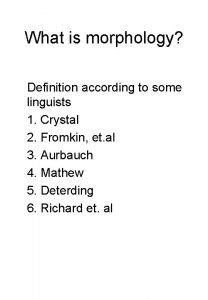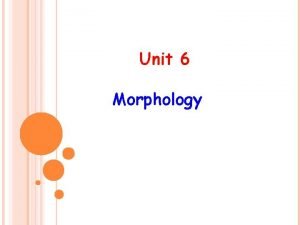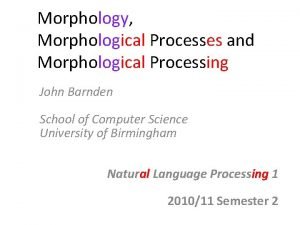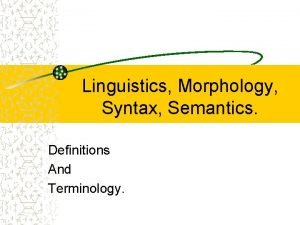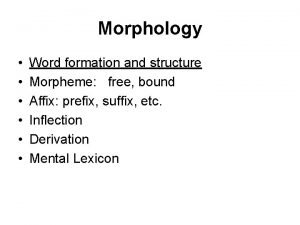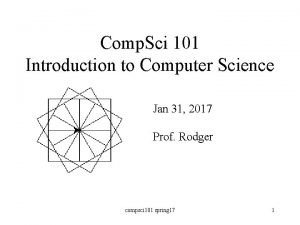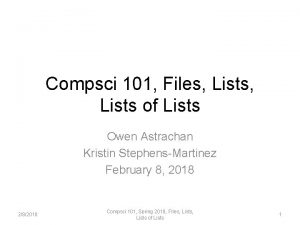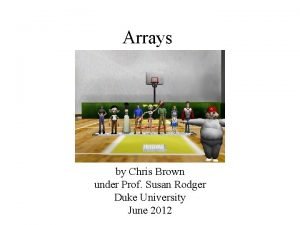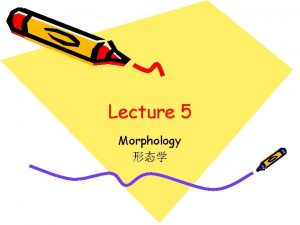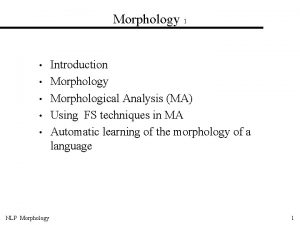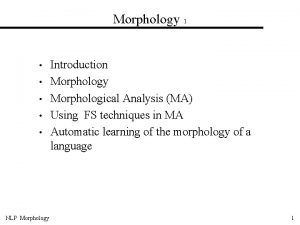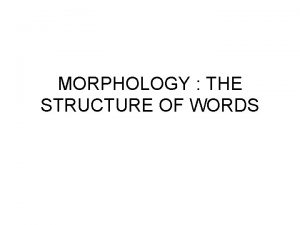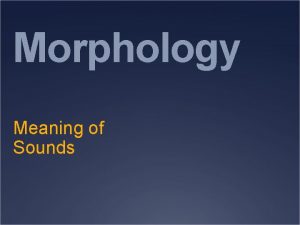Morphology II Linguistics 101 Gareth Price Duke University



















- Slides: 19


Morphology II Linguistics 101 Gareth Price Duke University

Derivational vs Inflectional Morphemes ‘derive’ – make something from = make new word change syntactic category (sometimes) Eg. Verb – noun change meaning ‘inflect’ – inflectere change shape (of a completed word) change grammatical function but not syntactic category (and not ‘meaning’ per se) number/person / gender tense / comparative / superlative

Which are derivational morphemes in this list? • • • • plinkling grimoulously klints twongier pendy thrustling stangliness centomer splimly centome stribble plinkleable decentome plinkler stribbling • • • • klintish liggeted pendierr pentful glosselstrop thrustle stromp grimulous acturously ponymous brimney stang parples stribbled klint • • • • unplinkleableness twength parple sloke pendiest fustered twong restribble sloken klintly acturous stangs strissed twongest liggets

Derivation • • • Plinkler Plinkeable Unplinkleableness

Inflection in Paku: Rules? • me "I" meni "we" • ye "you(singular)" yeni "you(plural)" • we "he" weni "they” (masculine) • wa "she" • wani "they” (feminine) • abuma "girl" abumani "girls" • adusa "boy" adusani "boys" • abu "child" abuni "children"

Roots, Stems and Affixes • • • Root + affix = complex word Black + en = blacken (root + suffix) adjective + suffix = verb blacken + ed = blackened verb + suffix = past tense verb black = root and stem for blacken black = root & blacken = stem for blackened unblackened = prefix + root + suffix but. . . unhappiness? un + happy + ness? un + knowledge? / un + ability?

Constraints on Derivation • Untruthfulness *untruthsfulness • Untruthfullnesses • derivational morphemes appear before inflectional morphemes in English • Free Root Morpheme: dog, phone, take, etc. • Bound Root Morpheme: deceive, unkempt, discover, under, nonchalant, etc. • reason? Usually some kind of historical linguistic accident. . .

Constraints on Derivation • • indecisive or imdecisive? inordinate or imordinate? inpossible or impossible? reason? Phonological rules of English (and the principal of efficiency) • Legalise / lawful-ise • Finalise / *permanent-ise • reason? Derivational morphemes have restricted distribution for reasons we don’t really understand.

Infixes • • Tagalog: takbuh ‘run’ – t-um-akbuh ‘ran’ lakad ‘walk’ – l-um-akad ‘walked’ Insertion of an affix within a base: • . . . in this case before the first vowel.

Infixes • • • Arabic: katab ‘write’ kutib ‘have been written’ aktub ‘be writing’ uktab ‘being written’ Insertion of two vowels sounds among the three consonants which comprise the root

Circumfixes • Bound morphemes that are attached to a root or stem morpheme both initially and finally. • Example: chokma “(he is) good" ikchokm o "he isn’t good" (Chickasaw Language) • So ik + adjective + o = negation

Internal Change • Changes in an internal non-morphemic segment to illustrate grammatical contrast. • sing – sang – sung • sink – sank – sunk • foot – feet • goose – geese • In English, there is a vowel change (ablaut) to mark past tense. • Not the same as umlaut: ‘fronting’ of vowel in response to front vowel in following syllable • go: s go: iz gi: s • Not infixing, however, as not changing the base *gs or *sng or *ft • no such morpheme as ‘oo’/‘ee’ or ‘i’/‘a’

Suppletion • • • Can be completely different morph (sound): French: avoir ‘to have’ eu ‘had’ Spanish: ir ‘to go’ fue ‘(he) went’ German: ist ‘is’ sind ‘are’ English: to be/is/are/we/were / to go/went Note: not allomorph, as not changed due to phonological environment, but grammatical category

Suppletion or Internal Change? • But. . . think / thought seek / sought catch / caught • Probably extreme forms of internal change – sometimes called partial suppletion

Reduplication • • • Indonesian (full) Orang – man Orang-orang – all sorts of men Anak – child Manga – mango Etc. Tagalog (partial): Bili – buy Bibili – (will) buy

Compounding • • • Putting together whole lexemes (words) to form new Green + house = greenhouse Bat + man = batman German fern-seher = far seer = ‘television’ Finnish lammas-nahka-turkki = sheep skin coat Tagalog tanod bayan = guard town = ‘policeman’ tubig ulan = ‘water rain’ = ‘rain water#

Hwk: Isolating vs Synthetic • Isolating • Synthetic – polysynthetic – fusional – Agglutinative Find an example for each, and describe why it is that category. Also list some examples of morphemes in that languages, and describe the rules, and explain whethere is inflectional or derivational morphology in your examples/

Hwk II • • Ex 2 – 5 p. 176/7 Ex 21 p. 181 Ex 29 p. 183 Ex 41 p. 189
 Gareth price duke
Gareth price duke Plinkling
Plinkling Kilala bilang minimum price policy
Kilala bilang minimum price policy Language
Language Applied linguistics
Applied linguistics Morphology linguistics
Morphology linguistics Morphology definition linguistics
Morphology definition linguistics Morphology definition linguistics
Morphology definition linguistics Examples of morphological processes
Examples of morphological processes Morphology meaning linguistics
Morphology meaning linguistics Types of morphology
Types of morphology What is syntax and semantics
What is syntax and semantics Morphemes in deactivation
Morphemes in deactivation Morphology meaning
Morphology meaning Inflectional and derivational morphology
Inflectional and derivational morphology Compsci 101 duke
Compsci 101 duke Compsci 101 duke
Compsci 101 duke Duke university blockchain course
Duke university blockchain course Duke visa services cpt
Duke visa services cpt Susan rodger duke
Susan rodger duke





